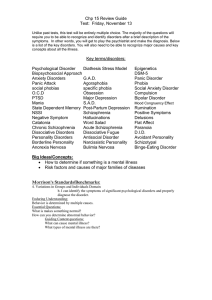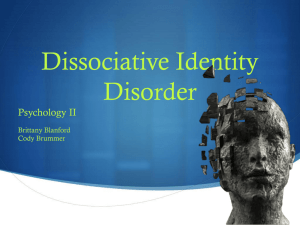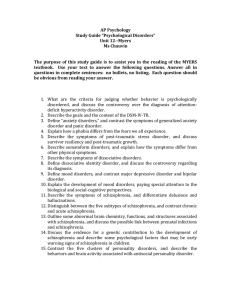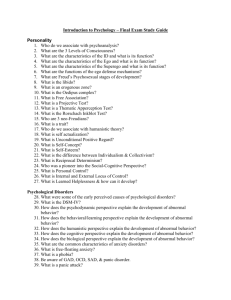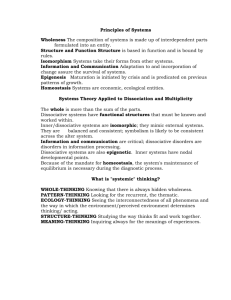CHAPTER 31 DISSOCIATIVE DISORDERS
advertisement
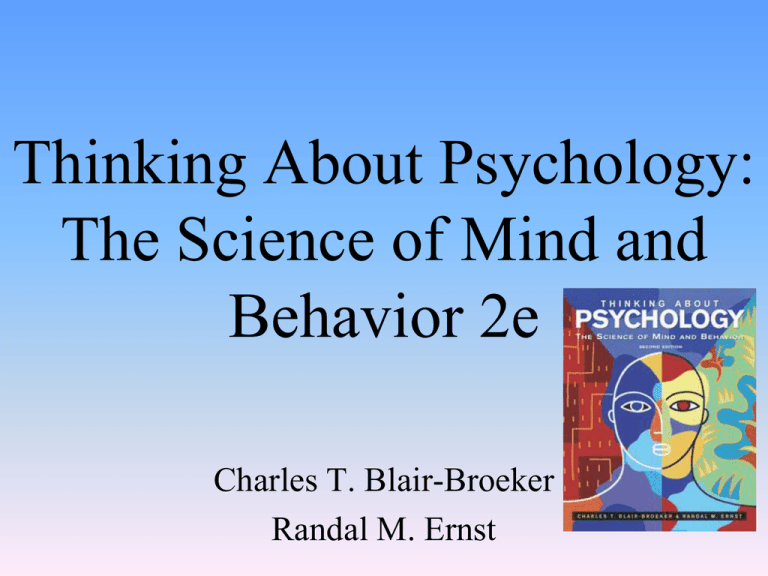
Thinking About Psychology: The Science of Mind and Behavior 2e Charles T. Blair-Broeker Randal M. Ernst Variations in Individual and Group Behavior Domain Psychological Disorders Chapter Module 31 Dissociative, Schizophrenia, and Personality Disorders Clarify • Dissociation is not the same as psychosis. Dissociation involves breaking away from the sense of self, either by losing memory and identity or by adding personalities. Psychosis involves a break with reality, believing things that are untrue, or having hallunciations about things that aren’t there. Module 31: Dissociative, Schizophrenia, and Personality Disorders Dissociative Disorders Dissociative Disorders • Disorders in which the sense of self has become separated (dissociated) from previous memories, thoughts, or feelings Types of Dissociative Disorders • Three main types: – Dissociative Amnesia – Dissociative Fugue – Dissociative Identity Disorder Dissociative Disorders Module 31: Dissociative, Schizophrenia, and Personality Disorders Dissociative Disorders: Dissociative Amnesia Dissociative Amnesia • A dissociative disorder characterized by loss of memory in reaction to a traumatic event • Example: soldiers in combat – Young man in a boat wreck; only survivor; traumatic and so losses memory of incident. Module 31: Dissociative, Schizophrenia, and Personality Disorders Dissociative Disorders: Dissociative Fugue (fUge) Dissociative Fugue • A dissociative disorder characterized by loss of identity and travel to a new location – From the same root word as fugitive. • The person may develop a new identity and begin a new life. – Can last a few hours, months or even years. – Unconscious response to stress (as with other dissociative disorders) Module 31: Dissociative, Schizophrenia, and Personality Disorders Dissociative Disorders: Dissociative Identity Disorder Dissociative Identity Disorder • Rare and controversial dissociative disorder in which an individual experiences two or more distinct and alternating personalities • Formerly called multiple personalities – Before the 1970s fewer than 100 cases had ever been reported. – In the 1980s alone, reports of more than 20,000 diagnosed cases appeared, almost all of them in North America Controversy • Psychologists debate whether is really exists. Are today’s clinicians simply more knowledgeable and willing to make a diagnosis? Are there better diagnostic rules (thus reducing the number of cases that were misdiagnosed as other things, like schizophrenia)? • Skeptics believe the power of suggestion has been at work. Clinicians (who have read about the disorder) may be unintentionally suggesting multiple personalities to their clients. Dissociative Identity Disorder • Personalities can be different ages, sex, and self perception of characteristics • Three Faces of Eve • Sybil Dissociative Identity Disorder • Insert “Multiple Personality Disorder” Video #31 from Worth’s Digital Media Archive for Psychology. • Instructions for importing the video file can be found in the ‘Readme’ file on the CD-ROM. • This same clip is on the Brain Series. • Oprah - Jani Dissociative Identity Disorder • Many videos on Learner, all three sites. • Oprah: Art Therapy and Dissociative Identify Disorder; Kim Noble; Module 31: Dissociative, Schizophrenia, and Personality Disorders Schizophrenia Disorders Schizophrenia • Group of severe disorders characterized by disorganized and delusional thinking, disturbed perceptions, and inappropriate emotions and actions • Is not one disorder but a family of disorders • Is not “split personality” • Occurs in about 1% of the population Schizophrenia • Play “Schizophrenia: Symptoms” (5:39) Module #26 from The Brain: Teaching Modules (2nd edition). Module 31: Dissociative, Schizophrenia, and Personality Disorders Schizophrenia Disorders: Symptoms of Schizophrenia Symptoms of Schizophrenia • Symptoms of schizophrenia include: – Delusions (false beliefs) – Hallucinations (false perceptions) – Inappropriate emotions or behaviors – Perhaps the most frightening & most misunderstood psychological disorder. – “Schiz” means split, but not slit from personality; it’s a split from reality – Affects 1% of the world’s population; typically develops in late adolescence or early adulthood and strikes men at a slightly greater rate than women. Symptoms of Schizophrenia Delusions • False beliefs that are symptoms of schizophrenia and other serious psychological disorders • Four major types of delusions: – Grandeur – Persecution – Sin or guilt – Influence Delusions of Grandeur • False beliefs that a person is more important than they really are • Patients may believe they are a famous person (e.g. Napoleon) Delusions of Persecution • False beliefs that people are out to get the person • Believe they are being followed, the phone is wiretapped, etc. Delusions of Sin or Guilt • False beliefs that the person is responsible for some misfortune – Plane crash because you didn’t brush your teeth Delusions of Influence • False beliefs of being controlled by outside forces – “the devil made me do it” Hallucinations • False perceptions that are symptoms of schizophrenia or other serious psychological disorders • Types of hallucinations: – Auditory (hearing voices) – Visual (seeing things) – Tactile (feeling skin sensations) • Can also have distorted smell and taste Inappropriate Emotions/Behaviors • Flat affect – showing little or no emotional response • Word salad – nonsense talk • Waxy flexibility – the person’s arms and legs will remain in place after being moved there • Inappropriate actions – speaking too loudly or engaging in odd mannerisms Module 31: Dissociative, Schizophrenia, and Personality Disorders Schizophrenia Disorders: Types of Schizophrenia Types of Schizophrenia Paranoid Schizophrenia • Characterized by delusions, especially grandeur and persecution. Auditory and other hallucinations support the delusions. A Beautiful Mind Catatonic Schizophrenia • Characterized by variations in voluntary movement • Catatonic excitement – rapid movements with delusions and hallucinations • Catatonic stupor – little or no activity, movement, or speech (waxy flexibility) Disorganized Schizophrenia • Characterized by bizarre behavior, delusions, and hallucinations. • Very disturbed thought and language (word salad) Undifferentiated Schizophrenia • Symptoms that don’t clearly fit into one of the other types of schizophrenia but still show clear symptoms of schizophrenia Schizophrenia in the Real World • Play “Cop Psychiatrists” (10:30) Segment #32 from Scientific American Frontiers: Video Collection for Introductory Psychology (2nd edition). Module 31: Dissociative, Schizophrenia, and Personality Disorders Schizophrenia Disorders: Causes Schizophrenia • Play “Schizophrenia: Etiology” (14:45) Module #27 from The Brain: Teaching Modules (2nd edition). Biological Factors - Genetics • Schizophrenia tends to run in families. • Genetics appears to produce a predisposition (increased likelihood) to develop schizophrenia. Genain Quadruplets Genetics and Schizophrenia Biological Factors – Brain Structure • Brain structure of those with schizophrenia is different than the normal brain • Those with schizophrenia have smaller amounts of brain tissue and larger fluid filled spaces. • The thalamus is smaller in those with schizophrenia. Biological Factors – Brain Function • The brain of those with schizophrenia operates differently than the normal brain. • The frontal lobes show less activity. • Those with schizophrenia have a larger number of receptor sites for the neurotransmitter dopamine. Biological Factors – Brain Function Schizophrenia • Insert “The Schizophrenic Brain” Video #29 from Worth’s Digital Media Archive for Psychology. • Instructions for importing the video file can be found in the ‘Readme’ file on the CD-ROM. Biological Factors – Prenatal Viruses • A viral infection during the middle of pregnancy may increase schizophrenia risk. Psychological Factors • Two main areas: – Stress – Disturbed family – It’s unclear whether these are causes or consequences of schizophrenia. Module 31: Dissociative, Schizophrenia, and Personality Disorders Personality Disorders Personality Disorders • Psychological disorders characterized by rigid and lasting behavior patterns that disrupt social functioning • Divided into three clusters: – Related to anxiety – With odd and eccentric behaviors – With dramatic or impulsive behaviors Difficult to Diagnose • Behaviors are rigid (not flexible) and enduring. • Where should the line be drawn between eccentric, anxious, and odd & having a personality disorder? • How might treatment for a personality disorder be difficult? Personality Disorders Module 31: Dissociative, Schizophrenia, and Personality Disorders Personality Disorders Related to Anxiety Avoidant Personality Disorder • So sensitive about being rejected that personal relationships become difficult Dependent Personality Disorder • Behave in clingy, submissive ways and displays a strong need to have others take care of them Module 31: Dissociative, Schizophrenia, and Personality Disorders Personality Disorders with Odd or Eccentric Behaviors Paranoid Personality Disorder • Shows deep distrust of other people, which gets in the way of personal relationships Schizoid Personality Disorder • Is detached from social relationships • Are true hermits, preferring life alone and avoiding intimate interactions at all costs Module 31: Dissociative, Schizophrenia, and Personality Disorders Personality Disorders with Dramatic or Impulsive Behaviors Borderline Personality Disorder • Exhibit instability of emotions, selfimage, behavior, and relationships Antisocial Personality Disorder • Personality disorder in which the person shows a lack of conscience for wrongdoing • Shows no respects for the rights others • Usually male; can be very charming • Also known as psychopathic or sociopathic personality disorder – Think Silence of the Lamb The Antisocial Personality Disorder • Insert “The Mind of the Psychopath” Video #30 from Worth’s Digital Media Archive for Psychology. • Instructions for importing the video file can be found in the ‘Readme’ file on the CD-ROM. • This video clip is also part of The Mind series segment. The Mind of the Psychopath • Play “The Mind of the Psychopath” (18:39) Segment #35 from The Mind: Psychology Teaching Modules (2nd edition). • Parts of this video clip are included in the Worth Digital Media Archive CDROM. The End
